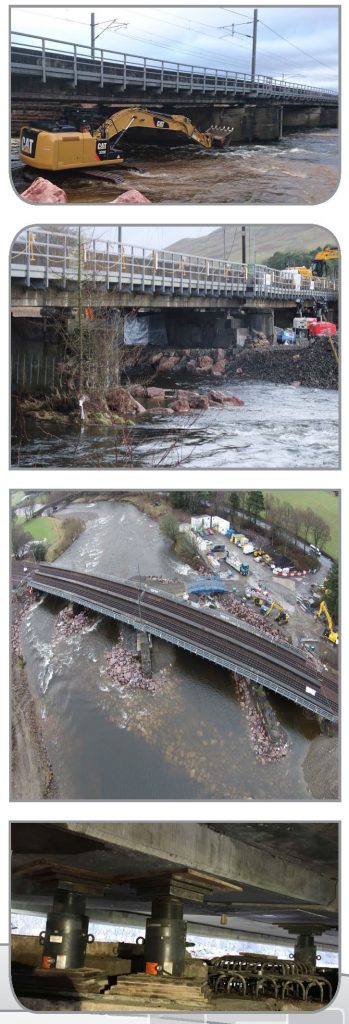 Jacking and Bearing Replacement
Jacking and Bearing Replacement
Client
Network Rail
Principal Contractor
AMCO
Works Commenced
January 2016
Works Completed
February 2016
Lamington Viduact carries the West Coast Main Line between Carstairs and Lockerbie over the River Clyde. The viaduct was in danger of collapse following significant flooding on New Year’s Eve 2015. Scour beneath the central pier caused a 140mm depression on part of the bridge deck, and as a result, Network Rail was forced to close the viaduct to all trains, severing the WCML between Scotland and England.
Freyssinet was appointed by Network Rail’s Principal Contractor, AMCO as bearing replacement and jacking specialist in mid-January. Working closely with AMCO’s Engineer, Donaldson Associates, Freyssinet devised an emergency rescue plan which involved casting new jacket walls either side of the subsided pier to stabilise it and provide a surface to jack the bridge deck from. The deck had not subsided uniformly, it had twisted, so Freyssinet developed a jacking sequence to first take out the twist and then raise it to level. Four 250 tonne jacks were clustered around the central bearing and two were installed at each edge beam bearing.
As time was crucial, Freyssinet chose to bed the jacks on engineered marine plyboard, rather than on conventional bedding mortar. This innovation was a first for Freyssinet and design reassurance was obtained by crushing a sample of the plyboard in Freyssinet’s 20MN test press (normally used for testing bridge bearings) in Telford. This determined elastic and creep deformations for the material, giving the designers the necessary confidence to approve its use.
Having jacked the bridge to level, Freyssinet removed the old bearings and replaced them with new before lowering the bridge back down onto its new supports.
Contractors worked around the clock to stabilise the river bed, strengthen the pier, jack the bridge back to level and replace the damaged bridge bearings, and as a result the bridge was reopened a couple of weeks early on 22 February.
Several times during the works, the contractors had to leave site when the floodwaters returned. In total, about 7,000 tonnes of rock had to be placed around the various supports of the structure to protect it from the River Clyde.
Phil Verster, Managing Director of the ScotRail Alliance, said: “This project has been a hugely challenging one, involving working out in the Clyde through the worst of January’s storms in a race against time to save the structure. Our engineers have faced atrocious conditions throughout this project and I am really proud of their hard work and their absolute commitment to getting the line open again.”
